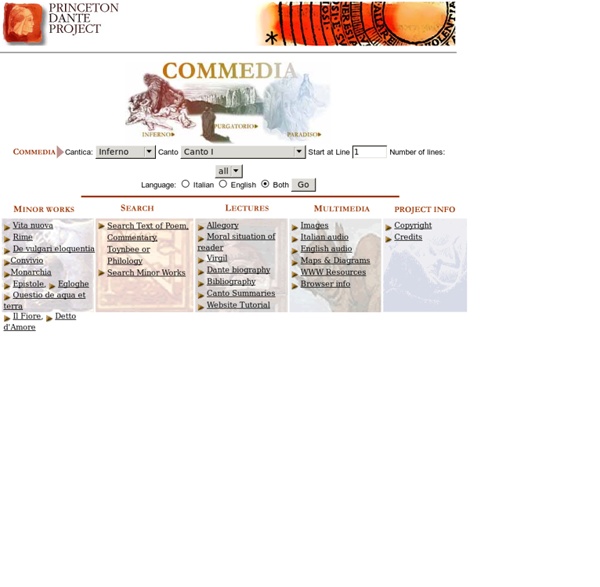



http://etcweb.princeton.edu/dante/pdp/
Related: Dante e la Divina Commedia • Sources • Italy/Italian • ItalianHome / Contents Page Welcome to 'Medieval Primary Sources—Genre, Rhetoric and Transmission'! This website provides a guide to the organisation and contents of the course. It is here that you will find detailed guidance as to the topics of the seminars and links to online facsimiles/images of the manuscripts which we will be discussing in class.
In Translation Exile My relationship with Italian takes place in exile, in a state of separation. Every language belongs to a specific place. Decameron Web Decameron: The Italian text of the Decameron is based on V. Branca's Einaudi edition (1992). Read Italian Text The English translation of the Decameron (J.
Jhumpa Lahiri Finds Freedom In Italian Memoir: 'No One Expected Me To Do It' In 1999, Jhumpa Lahiri won a Pulitzer Prize for her very first book, Interpreter of Maladies. Her 2003 novel, Namesake, was turned into a movie, and she went on to publish Unaccustomed Earth and The Lowland. But Lahiri wasn't satisfied. "I've always been searching to arrive at a certain voice that will probably elude me forever," she tells NPR's Ari Shapiro.
Inferno Illustrations by Gustave Dore Inferno illustrations by Dore Inferno Illustrations by Gustave Dore The illustrations shown here by Gustave Dore have an almost magical ability to transform the words of Dante -- and those of Dan Brown -- into beautiful images. They conjure this world in a way that we might not have imagined, and thereby add immeasureably to our experience of this other place. Illustrations specifically related to Dan Brown's novel can be found here. Our journey through the underworld begins with the image above. Richard II's treasure: the riches of a medieval king Crown, c. 1380 and 1402: Munich, Schatzkammer der Residenz (Bayerische Verwaltung der Staatlichen Schlösser, Gärten und Seen) Inv. no. 16. See crowns. The treasure roll of Richard II, compiled in 1398/9, offers a rare insight into the magnificence of a late medieval English king.
The Malatestiana Library of Cesena The world offers its observers few examples of the past in which time has taken a sudden, abrupt stop. Pompeii is one example; a city preserved by the disaster that smothered it. When time takes a stop, we can imagine exactly the thriving city seconds before. Medieval and Modern Thought Text Digitization Project: Welcome Welcome "To strengthen Stanford University Library holdings in the field of Western Medieval thought and its influence on modern times" The goal is to digitize on an ongoing basis printed reference works, source collections, and primary and secondary books in the broad area of medieval and modern thought. Current local research needs help to determine the material selected for digitization.
Where to find the most stunning masterpieces of Tintoretto - The Venice Insider Tintoretto is one of Venice’s most famous painters. With more than 700 works spread all over the city, it’s almost impossible to visit Venice without a glimpse on several of his paintings. The most difficult part is to choose which masterpieces you really want to admire in-depth.
Venetian grammar A peculiarity of Venetian grammar is a "semi-analytical" verbal flexion, with a compulsory "clitic subject pronoun" before the verb in many sentences, "echoing" the subject as an ending or a weak pronoun. As will be clear from the examples below, Venetian subject clitics are neither "redundant" nor "pleonastic" because they provide specific information, not present on verbal endings. Independent/emphatic pronouns (e.g. ti), on the contrary, are optional. Italian: (Tu) eri sporco ("You were dirty").Venetian: (Ti) te jèra onto or even Ti te jèri/xeri onto (lit. "(You) you were dirty").Italian: Il cane era sporco ("The dog was dirty").Venetian: El can el jèra onto (lit. "The dog he was dirty").Italian: (Tu) ti sei domandato ("You have asked yourself").Venetian: (Ti) te te à/gà/ghè domandà (lit.
Jhumpa Lahiri on Writing in Italian This week’s story, “The Boundary,” is about a teen-age girl who is the daughter of immigrants. Her parents are the caretakers for a holiday house—in Italy, we assume—and, as the story opens, the girl is showing a new family around at the start of their week’s vacation. You recently spent some years living in Italy. When did you first start thinking of this scenario as the basis for a story? The story was inspired by time I’ve spent in Capalbio, which is a town on the Tuscan Coast just over the border of Lazio, a quick journey from Rome. I got to know the area thanks to the photographer Marco Delogu, who was my neighbor in Rome and quickly became a good friend. Italian expression of the day: 'Acqua in bocca' Sometimes, learning Italian feels like a struggle. All the endless verb conjugations to remember, the words that mean ten different things, and confusion over which gender has been assigned to an inanimate object. No wonder many of us regularly feel like giving up in frustration. But one thing that's enjoyable about studying Italian is learning idiomatic expressions - those phrases that don't translate literally, but give the language so much of its colour.
Institute for Medieval Studies Select a link from the menu below to be taken to Web resources for that area. Please direct suggestions for other links to be listed here to Axel Müller. Chronological Periods Late Antiquity Ammianus Marcellinus Online Project This site introduces Ammianus and his work by means of a biography, short essays on important persons as well as aspects of his work, and a bibliography of important and recent publications. Aphrodias in Late Antiquity This is the electronic, expanded and revised second edition, originating from the version published by the Society for the Promotion of Roman Studies in 1989.